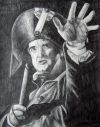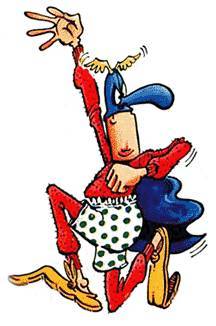Rocky to take the Winter Garden
#100Rocky to take the Winter Garden
Posted: 4/29/13 at 11:04pm
Here we go! Just for you, MisterMatt!
Apparently bith "Bow Sing" and Mme. Tortajada were curtain openers
===
The Musical Review of 1911
J.J. [Shubert]’s notion of “the Continental idea of Variété” was reflected in the Winter Garden’s very first show, The Musical Review of 1911 which premiered on Monday, March 20, 1911. The audience included “those from high society, the old guard of first nighters and many of the younger generation of theatregoers.”
The opening of the new playhouse was a stylish event. The New York World reported:
Last night, as is usual on such occasions, the show was not altogether the thing. The people in the audience came to be seen, quite as much as to see what took place on the stage. They swooped down upon the Broadway entrance in a flock of taxicabs that jammed the avenue as far north as Columbus Circle.…The theatre ticket speculators offered the extravagant amusement seekers in fur-lined overcoats front chairs at the trifling price of $25 a pair.
The gay world and its wife—let it be hoped that in every case it was its wife—turned out last night in extravagant finery and a great nudging, struggling, good-natured mob to christen the newest amusement place on Broadway and to celebrate the closest approach New York has yet made to the style of entertainment that is supposed to be most popular in the giddy centres of Continental Europe.
The opening fare consisted of various parts, and began with an overture directed by Oscar Radin, followed by Manuel Klein’s one act “Chinese” opera, Bow Sing. This musical drama centered on the tragedy of Bow Sing, a Chinese servant sold into bondage, and her adored English master who left her deserted and brokenhearted when he returned to his native England. The drama was J.J. [Shubert]’s nod to high culture, something he felt necessary to match his European rivals.
Reviews of the light opera were somewhat mixed. Klein was congratulated for his tuneful score and the authors received praise for a “worthy” libretto. The opera’s sets were described as “exceedingly Oriental, beautiful and effective” and the cast received reasonable acclaim for their singing and acting skills. However, the New York American described the piece as “sounding like ‘Mme. Butterfly,’ only not as much,” and then added, “Better still, it wasn’t very long.”
The New York Times noted: “It was not the composer’s fault if most of the principals were so inarticulate that the plot defied analysis unless one sought the printed explanation on the programme.”
“Bow Sing” was followed by a dance sequence interlude performed by Tortajada and her 16 Moorish maidens. The act received praise for its costuming, but the New York American offered: “Tortajada talked in pure Spanish and threw lots of kisses, but didn’t let herself loose in the dance. Large and lovely was Tortajada—also statuesque—but she was too wintry for last night.”
Finally, the curtain rose for La Belle Paree, the evening’s final segment, which combined variety, comedy, and music in an assortment of vaudeville sketches loosely structured around a common theme. The plot centered on a lonely American widow visiting Paris for her health. “A jumble of jollity in two acts and eleven scenes,” as the opening night program described it. La Belle Paree featured the full company of players and twenty-two musical numbers.
Enough Major Headliners for Two Shows
The show’s advertising reveals that the production was quite large, even for its day. Promotional material named thirty featured performers and a cast of 250 supporting players. Many well known headliners contributed to the show; more than enough to complete the casts of two typical Broadway productions. Mitzi Hajos charmed audiences by leaping from the stage to lead the orchestra while show girls in trimmed harem skirts paraded across the apron. The Hess Sisters did Russian dances; internationally acclaimed Mademoiselle Dazie danced; and Kitty Gordon displayed her ballyhooed back and sang “Monte Carlo Moon.” Opera diva Dorothy Jardon provided a lively rendition of “Trovatore,” and Jean Allwyn, Arthur Cunningham, Josephine Jacoby and Lenard Kirtley also had singing numbers. The act of Marion Sunshine and Florence Tempest contributed a notable dance number, and Mademoiselle Dazie and Grace Washburn took part in a convincing duel scene.
Popular international vaudeville artist Stella Mayhew was at the height of her career in 1911. In La Belle Paree, she played the part of the Widow’s maid. The first act found her and Jolson performing a bouncy duet entitled “Paris Is a Paradise for Coons.” Written by a young Jerome Kern the song professed the freedoms African-Americans enjoyed living in Paris rather than in “Yankee Land.” In addition to the duet, she introduced two solo numbers, “De Devlin’ Tune” and “What Kind of Place Is This?” Mayhew would perform in several Shubert productions over the next few years.
Al Jolson assumed the role of Erastus Sparkler, “a colored aristocrat from San Juan Hill, cutting a wide swath through Paris,”20 otherwise stated: “a phony from New York’s notorious Hell’s Kitchen.”21 The evening’s program indicates that he performed a specialty number, comedy and song, in the second act. Most likely this is where Aubrey Stauffer’s “That Lovin’ Traumerei” was introduced into the show. Not listing a specific song for the scene in the program allowed Jolson and the management some flexibility in choosing what number to perform on a given evening.
Several songs probably shared this spot during the show’s run.
La Belle Paree’s book was written by Edgar Smith; Edward Madden wrote the lyrics, Jerome Kern and Frank Tours the music. Arthur Voegtlin was credited with scene design and specialeffects, and Melville Ellis with costuming. J.C. Huffman and William J. Wilson directed. Over the course of the production’s run, music from a variety of composers was interpolated into the revue.
After an intermission of five minutes, the evening’s final routine was presented. Arranged by Ottokar Bartic of the Metropolitan Opera, The Ballet of Pierrots and Harlequins featured dance numbers by Mlle. Dazie and Signor Bonfiglio. The New York Herald’s reviewer noted that the dance sequence was “worth going long city miles to see.” A finale performed by the entire cast closed out the night’s entertainment....
The Musical Revue of 1911 closed on June 10 for the season’s summer hiatus and reopened the following September, playing in various eastern cities. The show’s concluding performance took place in Philadelphia on November 4, 1911.
Pages 8-13, The Passing Show: Newsletter of the Shubert Archive
#101Rocky to take the Winter Garden
Posted: 4/29/13 at 11:08pm
Rocky without the iconic "Rocky Theme"....how is that even possible? Or have they gotten permission to interpolate it into the score?
You mean The Eye of the Tiger? That is in the show according to the press release.
#102Rocky to take the Winter Garden
Posted: 4/30/13 at 6:37amEye of the Tiger doesn't even appear till Rocky III. The iconic, trumpet-laden Rocky 'training montage theme' is actually Gonna Fly Now - which, yes, is in the musical.
#103Rocky to take the Winter Garden
Posted: 4/30/13 at 10:16am
Wow, that certainly sounds like people go their money's worth for an evening's entertainment, PJ! Thank you for finding that! As for Träumerei, it sounds like the reference is to the famous piano solo by Schumann.
It makes me giggle when I think about what people deem "worthy" or Broadway when Broadway's early history, the actual FOUNDATION of Broadway, is always ignored. But I would love to get my hands on the score to Bow Sing out of sheer curiosity.
Träumerei




